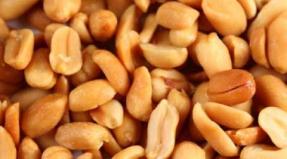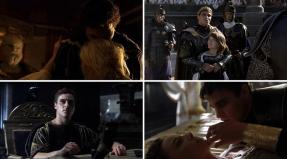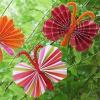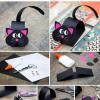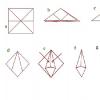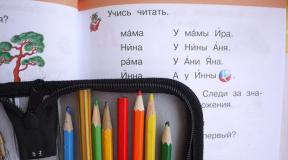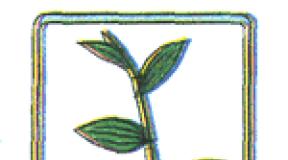Copper and bronze cast icons, crosses, folds in the life of a modern person. Copper folds and icons of russia
"The image is pure, worthy of veneration" ... These words can be used to define copper-cast icons and crosses created by Old Believers in the vast expanses of Russia - in the sketes of Pomorie and workshops in Moscow, in the villages of the Moscow region and the Volga region, in secret forges in the Urals and in Siberia - during less than three hundred years from the end of the 17th century. before the beginning of the XX century.
A new period in the history of copper casting is inextricably linked with the Old Believer movement in Russia, when in the second half of the 17th century, after the split of the Russian Orthodox Church, opponents of the reform of Patriarch Nikon were forced to flee from the persecution of the authorities, flee from the center to remote outskirts, and hide in the forests. In such difficult conditions, it was the Old Believers who preserved and continued the Old Russian traditions of bookishness, icon painting and applied art. As priceless relics, ancient copper-cast images were carefully inserted into icon-case frames and put into picturesque wooden or carved folds.
But the Old Believers not only preserved the ancient Russian heritage, but also created their own special religious and spiritual culture. Copper-cast images, “as having been purified by fire” and “not created by the Nikonians,” received widespread veneration among the people. The variety of forms, iconography, composition and decoration of the Old Believers' copper-cast crosses, icons and foldables is striking. Among this huge array of preserved copper-cast plastics, one can identify works created in specific workshops. It is no coincidence that already in the first half of the 19th century. there were such varieties, or categories of "low tide copper crosses and icons" - Pomor, Guslitsky (or Zagarsk) and Pogost, which became widespread among Old Believers of different communities and trends.
When looking at this bright and distinctive layer of Russian applied art, one should always remember that the development of copper foundry took place in very special conditions, contrary to the law and the will of the authorities. Russia's need for non-ferrous metal, so necessary for military needs, caused the appearance of decrees of Peter I in 1722 and 1723, prohibiting not only the production, sale, but also the existence of copper icons and crosses.
According to the action of these decrees, only crosses were allowed - vests and breast panagias. The Old Believers considered only the eight-pointed cross to be "correct", which was depicted in the center of the male and female pectoral cross. “May God rise and disguise Him ...” - these words of the prayer have become an obligatory part of the design of the circulation of the crosses - vests.
Despite the existence of this law, which had been in effect in Russia for 160 years, copper business in the Old Believers' environment, among the forests, in hidden hermitages, reached an extraordinary height of artistic embodiment.
The brightest page in the history of Russian sacred plastic art became icons, crosses and folds, made in the foundries of the Vygovsky Pomor community. This Old Believer monastery, founded in 1694 on the Vyg River, in Karelia, considered itself the successor of the ancient Solovetsky monastery on the White Sea, and its founders, Saints Zosima and Savvaty Solovetsky, as their heavenly patrons. It is no coincidence that the images of these saints were spread both on icons and on folding doors. Already in the first half of the 18th century. Vygovskaya Pustyn became the largest economic, religious and cultural center of the Old Believers. The handwritten books, icons, small sculptures created at Vygu were distinguished by the unity of the artistic style, which received the name "Pomor".
To satisfy the prayer needs of the adherents of the Pomor bespopov consent, first of all, “correct” crosses were needed. Copper-cast Pomor crosses with the image of the Crucifixion of Christ were cast in an eight-pointed shape and a strictly defined composition - at the upper end was depicted the Savior Not Made by Hands with the inscription “King of Glory IC XC (Jesus Christ) Son of God”. The same composition is repeated on a small Pomeranian cross, the central image of a pictorial icon, distinguished by the subtlety of writing and a pronounced decorative sound.
With further complication of the shape, the cross received lateral rectangular plates with paired images of the forthcoming Mother of God and St. Martha, the Apostle John the Theologian and the martyr Longinus centurion. Such icon case crosses were often cut into not only the icon case frames, but also decorated pictorial icons. These crosses were cast in the most different sizes - from very small ones, the surface of which was often decorated with multi-colored enamels, - to large gilded ones, decorated with exquisite ornaments on the back. Excellent molding, fine casting and meticulous finishing - all these distinctive features of the Pomeranian small plastics were achieved by the high professionalism of the chasers, casters and enamel craftsmen.
These signs were clearly manifested in the creation of a miniature composition "Savior Not Made by Hands", decorated with enamel of a rare dark red color.
The main types of products of the famous Vygovskaya "copper" were not only crosses, but also folds with a different composition of the valves (bivalve, tricuspid, four-winged).
Among the repertoire of the Vygov masters, a special place belonged to small bivalve folds, which received the name "Pomorskaya Panagia". The form of the Old Russian panagia, formed in small plastic, was creatively reworked by Pomor craftsmen. On the square doors in medallions against a smooth dark blue enamel background, there are compositions with the images of Our Lady of the Sign and the Old Testament Trinity. The decorative decoration of the other folding is distinguished by a combination of a white-pink background with spectacular contrasting yellow dots on the dark "corners". The reverse side of such miniatures was also decorated - in the form of one strict composition with the image of the eight-pointed Calvary cross, or in addition to the pattern in the form of a large rosette flower, colored with glassy enamels. Later, the Pomor craftsmen slightly increased the size of the folding fold and supplemented it with a third panel with the image of the Crucifixion of Christ. Decorated with bright enamels with contrasting dots, these miniature pieces are reminiscent of precious jewelry pieces created by ancient Russian masters. Such small folds could be worn as pectoral foldable icons.
The same breast icons created by Pomor craftsmen are small three-leaf folds with the image of the Deisus composition. The combination of dark turquoise and white enamel, embossed star rosettes on the smooth surface of the background and rays on the nimbuses distinguishes a miniature work of the first half of the 18th century. In this folding everything is admirable - the plastic development of the image and the thoughtful decoration of the front and back sides.
The most popular among the Pomor sculptures was the new iconographic version of the copper-cast three-winged folding "Deesis with selected saints", which was named "nine" by the number of figures depicted on the wings. In a certain composition of the saints, each of whom was dedicated chapels in the prayer houses of the Vygov community, the idea of \u200b\u200bthe intercession of the Mother of God and the saints of the created monastery was embodied. The variety of decorative decoration of folds, decorated with multi-colored vitreous enamels, decorated with contrasting dots or a rare range of pink tones, is striking. On the reverse of the left wing, a composition with the image of an eight-pointed Calvary cross was traditionally cast; the surface of other leaves could be decorated with a large rosette or cartouche. After visiting the Vygovskaya monastery, it was possible to carve a memorable date, initials or the name of the owner on the surface of the smooth frame.
The second version of the folding "Deesis with selected saints" also became famous, on the side panels of which a different composition of the saints was depicted. Compositions of flaps of this folding have become widespread in the form of separate small "one-shot" icons.
The program work of the Pomor foundry workers was the four-winged folding, or, as it was solemnly called, “large festive wings”. It is believed that originally a model of a large three-winged folding folding was made, on the hallmarks of which the twelve holidays are represented. Later, keeled kokoshniks and a fourth alignment were added to such square sections - this is how the image of a full four-leaf folding was formed. On the first three sections on the hallmarks, twelve feasts are represented, and on the fourth - scenes of worship of the images of the Mother of God. This copper-cast piece of art, which has become a marching iconostasis, is distinguished by the integrity of a single creative concept. On the reverse side of one of the sash, there is traditionally a composition depicting the Calvary cross in an ornamental frame-headpiece. A special feature of individual copies will be the decoration of the turnover of the sash with a lush embossed ornament of curling shoots with a cartouche in the center. By order of the owner, a commemorative inscription could be cut on the surface of such a smooth frame.
After the creation of this four-winged folding vygov historians, probably, and could say about the mentor Andrei Denisov, that he "brought and arranged in the proper order the existing form in the copper-cast sections, which until then was absent-minded."
It is still unknown who was the author of the model of the four-fold folding folding arm? Among the foundry masters on Vygu, whose names we know from written sources, were Novgorodians and people from different cities and villages. Both scribes and icon-makers, who painted picturesque images for the worshipers of the Vyhov monastery, could have taken part in the creation of samples of Pomor miniature sculpture.
The high professionalism of the Vygov craftsmen consisted in the creation of a collapsible folding model, which made it possible to cast not only icons in the form of separate sections of independent stamps, but also various iconographic versions of three-leaf folding folding devices with images of festive compositions.
One of the most revered among the "desert dwellers" and numerous pilgrims will be a three-winged folding with the image of the twelve feasts "The Assumption of the Virgin. Resurrection of Christ (Descent into Hell). Epiphany". A special attitude to this type of folding is associated with the main cathedral chapel of the Vygov community and its patronal holidays.
The accumulated skills of foundry contributed to the wide scope of the craft - the production of copper crosses and the gate were engaged in 5 sketes of the Vygov community. The products cast in these remote forges were sent to the monastery and then transported throughout the Russian land. Preserved handwritten texts of edicts-instructions on foundry and enamel art, compiled by Pomor craftsmen. They passed on their experience, advised how to prepare the ground for casting, grind the enamel and put different colors on the frames and crosses. “Then practice yourself in every business and in all sciences and be clear and skillful in everything” - with these words the unknown master ends his instructions on foundry and enamel.
To the circle of Pomor plastics belonged the marching iconostases, which included in their composition a cross - a crucifix surrounded by stamps depicting festive subjects and valves of the Pomor panagia, and in rare cases - and individual miniature images. Similar small pectoral icons with images of the Mother of God Hodegetria of Smolensk, the holy martyrs Kirik and Ulita and St. Nicholas the Wonderworker accompanied people during their wanderings and travels across the endless expanses of the Russian land. It is no coincidence that the Pomor craftsmen created another version of the three-winged folding folding arm, on the wings of which three different subjects are connected: “St. Nicholas the Wonderworker. Our Lady of All Who Sorrow Joy. Holy Martyrs Kirik and Julitta with selected saints ”. Such an elegant gilded fold, cast in one of the skete workshops, as a Pomor relic, became a precious prayer image until the end of life ...
Copper-cast icons, crosses and folds, created by talented Pomor casters and enamellers, have become models for numerous workshops throughout Russia, including for small handicraft establishments in Moscow, Vladimir, Nizhny Novgorod and other provinces. Thanks to the work of these rural foundry masters, copper icons and crosses, which have become widespread among the people, have become a widely available form of applied art.
The main place in the assortment of products of these handicraft workshops was occupied by crosses, which differed not only in a certain iconographic program, but also in compositional diversity. First of all, guslitsky craftsmen cast large eight-pointed altar crosses with a relief image of the "Crucifixion of Christ" and the inscription "INTSI" (Jesus the Nazarene King of the Jews). Such crosses became widespread among the Old Believers-priests who accept the priesthood. "The Cross is the guardian of the entire Universe, the Cross is the beauty of the church ..." - this text has become an obligatory element in the design of the turnover of crosses that differ not only in size, but also in their decorative solution. A small cross with a high-relief image of the Crucifixion of Christ is adorned with gilding, which is cut into the centerpiece of a picturesque three-winged folding fold.
The iconic crosses, large and small, surrounded by icon-stamps and crowned with images of cherubim and seraphim on high pins, gained particular popularity in the folk environment. A clear compositional solution with a relief image of the Crucifixion of Christ, a combination of stylized plant and scaly ornaments, a two-color enamel scale highlight one of the expressive works of the guslitsky masters. The detailed iconographic program of a large iconographic cross, surrounded by 18 stamps with images of festive subjects, is a bright completion of the creative search of guslitsky foundry masters. Such crosses, often carved into picturesque icons or tinted boards, became the decoration of the interiors of many Old Believer churches.
From one handicraft workshop of the second half of the 18th century, it is possible that several works originate - a small icon "The Dormition of the Theotokos" and the middle of the folds "Selected Holidays", "Deesis with Selected Saints". The same shape of the top with the image of the Savior Not Made by Hands, a similar color range of enamels covering the surface of objects in a dense layer - these common technological, iconographic and stylistic features allow these items to be attributed to the same circle of copper-cast plastic. Later, the folds with a two-row composition "Deesis with the Selected Saints" will be cast with a massive dome, which will be decorated with a large flower rosette or the image of the Savior Not Made by Hands.
To the works of the late 18th century. owns a small crucifix, decorated with green and blue enamel, with three-part curved branch ends. A feature of this cross is the image at the lower end of the composition "St. Nicholas the Wonderworker and St. Nikita Beating the Demon".
To the best examples of copper-cast plastics of the 18th century. belongs to the three-winged folding "Savior of Smolensk with the Monks Zosima and Savvaty of Solovetsky", decorated with an elegant color combination of yellow, green and blue enamel. The decorative sound of the image was enhanced by white enamel, partially preserved on the centerpiece frame. The same composition of the saints is made on the folds of the fold "Our Lady of Odigitria of Smolensk", topped with a figured pommel. "I place all my hope in You, Mother of God ..." - these words of the prayer, which not only adorned the copper-cast image, but also filled it with sounding content, became the embodiment of a special veneration of the image Holy Mother of God.
In the XVIII century. there was also another composition of images on the folds' valves. Festive themes complement the composition of the folding, in the centerpiece of which, on the smooth surface of the blue-green enamel background, there is a relief image of St. Nicholas the Wonderworker.
Following ancient Russian traditions, the shape of the Guslitsky and Zagarsk three-winged folding folds, repeating in miniature the Royal Doors of the temple iconostasis, will find the widest distribution in compositions with images of the Virgin and selected saints widely revered among the people. The large "panels" "Archangel Michael with selected holidays" and "The Passionate Mother of God with selected saints", having the general shape of the keeled end of the centerpiece and doors and decorated with geometric patterns, are traditional works of the guslitsk casters of the 19th century.
It is when you look at these simple objects, made in small rural copper establishments, that you begin to understand and feel how completely special was the role of copper-cast plastic in the everyday life of a Russian person, with its joys and hardships. The image of St. Antipas of Pergamon, represented both on small light images and on folds, was prayed for relief from toothache. The wide veneration of St. Paraskeva Friday, the patroness of the family and trade, was embodied in a small, road-trip three-winged folding folding box and on an elegant gilded image, crowned with a pommel with six cherubs.
The Holy Martyrs Kirik and Ulita, who were revered as patrons of the family and children, were depicted both on small folds with selected saints, and as part of four-part compositions that repeated Pomor miniature images. Another composition, crowned with a complex ornamental pommel, includes “one-shot” icons “Saint Nikita slaying the devil”, “Martyrs Kirik and Ulita”, “Our Lady of Kazan” and “Saint Nicholas the Wonderworker”.
Such simple and modest images could be performed in numerous workshops of the Zagarsk villages of the Moscow region. So, in the villages of the Bogorodsky district of the Moscow province, which were "fed" by the copper industry, up to 150 establishments are known. But only a few of these workshops were engaged in casting crosses, icons and folds. In these rural establishments with traditional production, which included a smithy and a "printing house" - a room where "earth" was stored and forms were printed, simple and cheap products were cast, extremely rarely decorated with enamels ...
The craftsmen of these small handicraft establishments tried to expand their range and improve the quality of their products. So, in 1882, at the famous All-Russian art and industrial exhibition held in Moscow, Ivan Tarasov, a peasant from the village of Novoye, Bogorodsky district, Moscow province, was awarded "for copper images of very clean work and rather cheap prices." Later, in 1902, another master Fyodor Frolov from the same village, who owned a small handicraft establishment, presented his copper crosses at the All-Russian Handicraft Exhibition in St. Petersburg.
The proximity of the repertoire of the Zagarsk and Guslitsky copper-cast plastics and its widespread existence do not allow us to more definitely distinguish the products of each of these numerous rural workshops. So, at the beginning of the XX century. the well-known researcher of Pomor books and casting V.G. Druzhinin attributed all the plastic produced in the Moscow province to the category of "guslitskaya or zagarskaya" and noted such a sign as "lightness."
The products of the guslitsky masters were really light. Among these works, the casting made in the village of Antsiforovo stood out, which was sold in Moscow by weight in poods and much more expensive than the Zagarsk one. But the main distinguishing feature of guslitsk plastics, we believe, should be recognized as the increased decorativeness of copper-cast crosses, icons and folds. The surface of each guslitsky image is filled with an ornament in the form of curling shoots, stylized curls or simple geometric elements in the form of triangles, dots or stripes.
Plant shoots with small leaves and flowers adorn the image of the holy martyrs Antipas, Florus and Laurus. Another plant motif in the form of tall shoots with large buds-flowers, similar to the ornament of guslitsky manuscripts, was used by craftsmen to decorate the icon "St. Gregory the Theologian, Basil the Great and John Chrysostom". The openwork pommel with the composition "King is King", crowned with images of cherubim and seraphim on high pins, will become one of the distinctive elements of guslitsky copper-cast works.
The image of the Mother of God, the “warm intercessor,” in the guslitsk plastics will receive its unique artistic solution. The centerpiece of the folding "Our Lady of Kazan" with the pommel "Savior Not Made by Hands", "The Old Testament Trinity" and two cherubs are distinguished by an elegant combination of dark blue and white enamel. A curly shoot with flowers, adorning the halo of the Virgin and repeating against the background as the embodiment in metal of the words of the chant "like the Everlasting Color, we glorify Ty Bogomati", will become an integral part of the ornamental patterns of guslitsk icons.
The prayer chant will "sound" on the frame of the copper-cast icon "The Protection of the Virgin", decorated with glassy enamel of white, blue and green colors with rare spots of yellow. We believe that a special veneration of this image is associated with the Cathedral of the Intercession of the Most Holy Theotokos at the Rogozhskoye cemetery in Moscow, from the 18th century. which became the center of the Old Believers-priests.
The image of St. Nicholas the Wonderworker, merciful and quick in helping the intercessor of “all those who are in trouble,” will find the most vivid artistic embodiment in the copper-cast plastics of the guslitsk masters. An openwork top, a wealth of ornamental motifs in the form of a shoot against the background and a halo of the saint, stripes of curls in combination with bluish-black and white enamel create an image of increased decorativeness. Another large image, the entire surface of which is woven with ornaments and decorated with an elegant combination of white, bright blue and yellow enamel, will complete the creative search of the guslitsky masters.
In the foundries of the village of Nikologorsky Pogost on the Vladimir land, craftsmen produced copper-cast plastics with completely different characteristics. The craftsmen took into account the increased interest of the Old Believers in the ancient Russian "pre-Nikon" works and learned to imitate and even in a special way forge icons and crosses to match old samples.
The products of these workshops were bought in bulk by offeni merchants, who then not only sold icons and crosses to the surrounding villages, but also delivered goods to the fair in Nizhny Novgorod and other cities. For copper icons, the so-called "pogost" casting, we believe, is characterized by a special plastic design of the image, repeating the old Russian compositions, forms and ornaments. The sklad "St. Nicholas the Wonderworker (Mozhaisky)", close to the works of ancient Russian wooden carving, and the openwork icon "Saints Boris and Gleb", made using the perforated casting technique, are expressive samples of the products of these rural institutions.
Among the Old Believers, "ancient" copper-cast icons were especially popular, distinguished by a high-relief image of the Almighty Savior, with a two-fingered blessing gesture of the right hand and a closed Gospel in the left. The composition of the icon is completed by fields with a relief text of a chant dedicated to the feast of the Transfiguration of the Lord: "He was transformed on the mountain, Christ God, showed his disciples his glory ...". To confirm the “antiquity” of the created image of the master, the relief date “ZRV SUMMER” (7102 \u003d 1594) was cast on the back of such icons, apparently associated with a certain historical event at the end of the 16th century. The same date is cast on the reverse of the crucifix, which repeats the iconography of one of the revered ancient Russian samples.
Other features are the crosses, icons and folds made by the Moscow Old Believer workshops, which make up a huge layer of copper-cast plastic. Artistic casting by the Old Believers in Moscow has become a new stage in the development of this type of applied art. The rapid formation of foundry was facilitated by the formation of the largest Old Believer centers in the city. In 1771, during a plague epidemic, the Rogozhskoe (priest) and Preobrazhenskoe (bespopovskoe Fedoseevskoe) cemeteries were founded in different parts of Moscow.
Copper-cast products for the community of the Rogozhskoye cemetery were supplied from the guslitsky villages near Moscow. The situation was different with the production of copper crosses and icons for the community of the Preobrazhensky cemetery in the Lefortovo part of Moscow. In a short time, at the expense of wealthy merchant trustees, workshops were created for the correspondence of books and the production of pictorial and copper-cast icons. It is known that the founder of the community, Ilya Kovylin, traveled to Vyg and brought from there the text of the charter; in the image of the Vygovskaya monastery, the construction of the architectural ensemble of the Preobrazhensky cemetery was carried out.
We believe that Ilya Kovylin also got acquainted with the foundries that brought significant income to the Vygovskaya monastery. Already at the end of the 18th century, in the immediate vicinity of the Preobrazhensky cemetery, foundries were created on the territory of private households, which began to make crosses and folds "in the likeness of the Pomor." These workshops primarily worked for their communities in Moscow and other cities, whose parishioners "prayed only to copper images, and that was the work of their fellow believers."
After long disputes with the Pomors about the correct form and inscriptions in the composition of the Moscow-made crosses, a well-thought-out and substantiated program developed by Vygov's mentors found its embodiment. Following the Pomor iconography, at the upper end of the cross was depicted the image of the "Savior Not Made by Hands", above the "Crucifixion of Christ" the inscription was cast: "King of Glory IC XC (Jesus Christ) Son of God". The front surface of this cross, a crucifix, made in the second half of the 19th century, is decorated with multi-colored enamels that emphasize the main elements of the created composition.
A similar inscription: "Tsar of Glory IC XC (Jesus Christ) Son of God" was originally executed on the cross, which became the center of the composition of a large pictorial icon in a silver setting, made by Moscow masters of the early 19th century. But obviously, at the request of the owner, on the upper end of the copper-cast cross, the monogram “IC XC” was erased and the inscription “INTSI” was engraved.
Moscow craftsmen constantly worked to expand the range and decorative design of copper-cast works, including small crosses, which were in great demand. So, in the composition of the property of the Old Believers who lived at the Preobrazhensky cemetery, crosses are often mentioned - crucifixes "of a smaller size with the Mother of God and the Apostle John the Theologian." For stability, such crosses were cast with a small trapezoidal base. A similar widened lower end is also made on the cross - a crucifix with three-part curved ends of the branches, the surface of which is decorated with multicolored enamels.
Iconic crosses with the forthcoming Mother of God and Saint Martha, the Apostle John the Theologian and the martyr Longinus the centurion became widespread among the Moscow Old Believers. A special feature of another casting was the date "1879." and the monogram "M.R.S.Kh.", owned by Rodion Semenovich Khrustalev, one of the famous engravers.
In the traditions of the Pomor casting art, the three-winged folding "Deisus with selected saints", decorated with dense gilding, is executed. On the reverse side of this foldable there is a repeated composition depicting an eight-pointed Calvary cross in a figured cartouche.
In archival documents of the second half of the 19th century. often mentioned are three-leaf folds with the image of the Deisus composition, which has received a new decorative solution in Moscow copper establishments. The high quality of casting, conveying even the smallest details on the faces and figures of the Savior, the Mother of God and John the Baptist, distinguish these samples of the late 19th century. The surface of the valves is "woven" with a continuous floral ornament covered with glassy enamels. On the reverse side, in a decorated frame against the background of an unfolded panorama of the city of Jerusalem, the Calvary cross is depicted, protruding in relief against a sky-blue enamel background.
We believe that the Moscow masters embodied the idea of \u200b\u200ba large three-part "Deesis", which is a composite composition with a high-relief image of the Savior on the Throne and openwork images of the archangels Michael and Gabriel.
Among the Moscow works, the “two-vertex” image of the Savior of Smolensky has gained wide popularity. The iconography of this composition by the reverends Sergius of Radonezh and Varlaam Khutynsky reflected a locally revered pictorial image that was on the tower of the Moscow Kremlin and associated with the capture of Smolensk in 1514.
The appearance in the copper-cast plastic of a small double-leaf folding "Deisus. Guardian Angel and Saint Nicholas the Wonderworker ”, possibly, is also associated with the work of Moscow masters. The idea of \u200b\u200bheavenly patronage for the Preobrazhensky community, embodied in Deesis, was completed in the images of the guardian angel and St. Nicholas the Wonderworker. The appearance of this Moscow version of the double-leaf folding could be associated with the main prayer room in the male half of the architectural ensemble of the Preobrazhensky cemetery - the Assumption chapel and its chapel in the name of St. Nicholas the Wonderworker.
The design of the reverse side of this small folding folding device repeats the composition of the famous Pomor Panagia. A similar folding folding with the image of the "Old Testament Trinity" and "Our Lady of the Sign", decorated with white glassy enamel, is a vivid example of the work of Moscow enamel painters.
The masters have repeatedly turned to the creation of various versions of the composition "The Old Testament Trinity", among which the large-format image stands out, distinguished by a well-thought-out and balanced composition. The "two-vertex" image "The Old Testament Trinity", which has become widespread in the Old Believers' environment, is distinguished by the monogram of the master R.S. Khrustalev.
This Moscow master-chaser owns a large and varied range of monuments of copper-cast plastics, in which a special place is occupied by the four-fold folding "Twelve Feasts", made according to the model of R.S. Khrustalev. The increased dimensions of the folding fold, frames with embossed inscriptions over the stamps, multicolored enamels of the traditional Moscow scale distinguish this revised version of the Pomor fold.
Initials R.S. Khrustalev and his student (?), Master monogrammist S.I.B. Numerous small "one-shot" images are marked, repeating the hallmarks of a large four-winged folding with the image of the twelve feast days.
Such castings could have been made in one of the copper establishments that existed in the Lefortovo part of Moscow, on Ninth Company Street. The history of the workshop, which belonged to the Moscow bourgeoisie Irina and Aksinya Timofeev, is being reconstructed from documents from the first half of the 19th century. ... It is known that the products of this copper institution were sold not only in Moscow, but also in St. Petersburg and other cities of Russia. It is with this workshop that we can confidently associate the appearance of the model of the “two-peaked” image “Our Lady of Kazan”. The combination of multi-colored enamels in the centerpiece of the icon and on the wide margins, decorated with a stylized ornament in the form of a vine, creates a bright, elegant image. The icons "Our Lady of Kazan", created according to the model of the master Ignat Timofeev, found repetition in numerous castings of the second half of the 19th - early 20th centuries. ...
In the second half of the XIX century. the history of this copper establishment is connected with the new owner Ekaterina Petrova. The works of the workshop created during this period of its existence include the casting of such a large-format image as “Our Lady of Odigitria of Smolensk”.
Among the masterpieces of Moscow copper foundry and enamel art belongs the image of the Assumption of the Virgin. The multi-figured composition of the centerpiece is surrounded by wide margins decorated with intricate intertwining ornamentation. When you look at this copper-cast image, decorated with multi-colored enamels and gilding, you get the full impression of an icon in a precious setting. The effective use of contrasting colors of dark blue and white enamel enhances the decorative sound of this piece. It is possible that the original image was created for the Cathedral of the Assumption prayer house of the Preobrazhensky cemetery in Moscow. In the 1870s - 1880s. the model of this large-format composition was repeatedly "corrected" or "minted" by Rodion Khrustalev.
One of the brightest works of the famous master is the icon "Saints Gregory the Theologian, Basil the Great and John Chrysostom." The composition of the icon with the solemn staging of the figures of saints and the relief image of the Savior Not Made by Hands, the stylized floral ornament in the form of tall shoots with large buds, the decor in the form of stripes of enamel of blue, green, blue-black, yellow and white colors - all this creates an image of increased decorativeness ... The basis for this striking creation was the modest composition of the work of the guslitsa master. Later R.S. Khrustalev repeatedly worked to recreate the image of the three ecumenical teachers and saints, using the model of the first half of the 19th century. The monogram of R.S. Khrustalev, the image "The Fiery Ascension of the Prophet Elijah" is also noted, which received special veneration among the Old Believers.
Memories of the Krasnoselsky foundry worker Anfim Serov about the high quality of the work of the Moscow chasing masters are preserved: “... The uterus (model) ... is made by a master engraver. The work is very difficult, requiring a good master-practitioner ... The fact is that the model is pressed into the ground, then when it is taken out of the ground, it must come out freely, without taking the earth with it ... To make such a full-fledged model, the masters were only in Moscow ... " ... Such masters were Ignat Timofeev, Rodion Khrustalev, S.I.B. and other chasers, often known to us only by their initials on numerous copper-cast crosses, icons and folds of Moscow origin.
A small copper-cast icon depicting the Apostle John the Theologian and his disciple Prokhor praying to the image of the Savior Not Made by Hands against the background of the architectural ensemble of the Preobrazhensky cemetery had a memorable character for the Moscow Old Believers. The copper image of the "Prophet Daniel", a saint of the same name to Daniel Vikulin, one of the founders of the Vygovskaya Pomor monastery, had a similar memorable significance. Unlike the Pomor samples of the 18th century. with a dull smooth background, the Moscow castings with the image of the saint are made using the perforated casting technique.
Moscow foundry masters constantly worked on the creation of new iconographic versions of large and small compositions with images of saints. The image of the martyr Tryphon, depicted with a bird in his hand, was widely respected among the Old Believers. An extended version of the story of the rescued princess is reflected in numerous casts depicting the scene "The Miracle of George and the Dragon." Saints John the Warrior, Charalampius and Bonifatius, depicted in the centerpiece of a small copper-cast icon, were revered as an assistant
At the moment, there is no special research devoted to Old Believer copper casting in the Komi Territory. In 1996, an article by N.N. Chesnokova (1996) was published, which suggests using casting as one of the sources on the history of the formation of ethno-confessional groups in the Pepechorye region. On the territory of the Komi Territory, copper casting became widespread among both Russians and Komi Old Believers living in the lower reaches of the Vashka, the upper reaches of the Vychegda, in the middle and upper Pechora. There is currently no information about the existence of a local production center. The only mention of the casting of icons in the Upper Pechora, found in the report of Yu.V. Gagarin (Scientific report 1967), does not have any confirmation.

Now the majority of the inhabitants of Old Believers' villages do not consider themselves Old Believers: "We are not Old Believers, we are worldly, Old Believers are those who eat from separate dishes." It is difficult to establish what ideological principles the Verkhnyaya Vychegda Old Believers adhered to at the moment, they have no idea of \u200b\u200bmeaning and agreement, a similar situation can be observed in other regions. Komi Old Believers of Vashka and Verkhnyaya Vychegda believe that casting (kört öbraz, yrön öbraz) has greater grace than painted images; at the household level, they explain it more by practicality. On the beat, they say that the metal images are real, they were brought (wema tor), they made knowledgeable people, and the written ones are of local production (as karöm) (field materials of the author 1999).
Cast objects are used in ceremonies accompanying the birth and the first years of a child's life: during baptism, water in the font is blessed with a small image, the crucifix is \u200b\u200bplaced in the baby's cradle, which is associated with traditional ideas about the cross as a talisman. In wedding rituals, folds, images are usually given as a dowry; despite the existing ban, in a number of cases the folds are taken apart so that the daughter can take it with her to her husband's house. The presence of casting in the funeral ritual is mandatory: at the moment the body is in the coffin, at the commemoration of the dead, cast images and crosses are cut into the grave monuments (now they do not embed them, but bring them to the cemetery). Cast icons, folds, crosses are used to consecrate water during church holidays.
In the folk environment, there is a certain classification of casting: the division into women and men (according to plots, storage place - in shevnos ud., Yin pov vvch.), Personal and exhibited in the goddess, worldly and "Old Believer" (did not differ in images) (field materials of the author 1999).
Copper casting, different in iconography and subjects, is used for similar purposes by the Russian Old Believers of the Lower Pechora; among the Komi non-Old Believers, it is less common, which allows us to speak of casting as a specific feature of the culture of the Old Believers. Considering the role of casting in rituals, the peculiarities of which determine confessional affiliation, the range of objects cannot be random.
Based on the iconographic and technological differences, it is possible to determine to which agreement the owner belonged, to trace the contacts of the Komi Old Believers with the Old Believer communities in other regions, as well as the connections between the communities within the republic, to more accurately determine the areas of distribution of the Old Believers.
Udora (dd. Koptyuga, Muftyuga, Vilgort, Ostrovo, village Chuprovo, Puchkoma, Vazhgort). Pomor castings of the 19th century prevail, there are products of Moscow production (Preobrazhenka). It should be noted the presence of castings belonging to the Central Russian tradition (Guslitsy), presumably dating back to the 18th century, these are not only images and folds, but also crosses with the title "IHTS.H.", Such objects are less common, few in number (p. Chuprovo, Koptyuga, Ostrovo).
It is believed that the Udor Old Believers were Filippovites, since the 60s of the XIX century, there were secrets, the presence of guslitsky casting, and, as a rule, an earlier one suggests that supporters of other faiths lived here. About the residence of two priests in the village of Kirik, reports Yu.V. Gagarin. (1980). It is known that guslitsky casting was in use among the Old Believers - priests, as well as the fact that crosses with a title were taken by the Fedoseevites (after 1751, the "Titlovians" who separated from them).
Old Believers Udora maintained contacts with Pomorie, Moscow, Ust-Tsilma (Gagarin Yu.V. 1973).
The predominance of Pomor casting allows us to speak of a relatively homogeneous confessional affiliation of the population of these villages.


Ust-Kulomsky district. In the Old Believer villages of Voch, Kerchomya, there is a guslitsk, Central Russian casting, mostly of the 19th century; Pomorskoe, Moscow (Preobrazhenka-?) casting of the 19th century; there are instances that are difficult to date and attribute. It was not possible to reveal the predominance of one tradition. However, the most popular subjects can be named: Crucifixion and images of the Mother of God (v. Kerchom'ya, Voch). During the funeral, it is necessary to have a cast icon on the chest of the deceased, if a man, then it must be a Crucifix, if a woman is the Mother of God (field diaries of the author 1999). This confirms the information about the living in these villages of supporters of the Spassov (so-called deaf netovshchina) consent. It is believed that Spassov's copper casting can be distinguished by the fact that the Image Not Made by Hands was necessarily placed on the top, and only 2 types of icons were distributed: images of the Savior and the Mother of God (Old Believers, 1996).
Copper casting is recorded in the village. Derevyansk - 7 items, Kanava village, Vapolka village - one each. 6 (figurines, folds, cross) are identified as guslitsky casting (most of them have a rectangular pommel "Spas na ubrus"), 2 skladnya-Pomorsk (Moscow-?). In Dereviansk, the casting was removed from the church in the 1920s, in the village of Vapolka, a fold was found in an abandoned house.
Considering trade ties with Cherdyn, contacts with the population of the Upper Pechora, it can be assumed that representatives of other consents, possibly Pomorian, lived on the Upper Vychegda, as evidenced by the spread of Pomor casting (crosses, folds). The existence of guslitsky crosses and folds of the 19th century suggests that Old Believers-priests lived in this area.
Patchwork. Out of 35 items, 15 were purchased in Syktyvkar; 6 - in the Sysolsky district (the village of Pyeldino); 3 - in Syktyvdinsky (Palevitsy village, Zelenets village); 2 each - in Koigorodsky, Ust-Vymsky, where the others came from is unknown. Casting from different centers is presented: Pomorskoye, Moscow, Guslitskoye. These are folds, icons, images, crosses dating back to the 19th century.

Scientific archive of the Komi Scientific Center of the Ural Branch of the Russian Academy of Sciences
Fund 1, op. 13, file 159. Scientific report of the 1967 ethnographic expedition to the Troitsko-Pechora region of the Komi ASSR
In an open-collar jacket,
With a naked head
Slowly passes by the city
Uncle Vlas is a gray-haired old man.
On the chest there is a copper icon:
He asks for God's temple, -
All in chains, poor shoes,
There is a deep scar on the cheek ...
ON. Nekrasov
Copper-cast plastic - crosses, icons and folds - is a major national phenomenon of Russian artistic culture. That very special attitude to copper casting, which existed in Russia for a millennium, has been completely forgotten in the people's memory over the past century.

Agree, in our modern world super-speeds there is absolutely no place left for faith in God. Today, for most people, it has been replaced by expensive cars and money. Money has become a cult. But just a hundred years ago, every Russian Orthodox Christian began and ended his day with a rather simple action - prayer, raising it to the Lord God, sharing with him all his sorrows and joys, which is now for modern man seems, to put it mildly, unusual.

But not all is lost, spirituality is beginning to revive in modern society, because without it, the revival of Russia as a great state is impossible. In other words, our country, as never before, needs to revive and strengthen unshakable moral values, to turn to the sources in order to strengthen the spiritual foundation of society, to act creatively.

Where does the path of an Orthodox person begin? That's right - from baptism. From holy baptism to the hour of death, every Christian should wear on his chest the sign of his faith - a pectoral cross. He is a symbol of our salvation, a weapon of spiritual struggle, a symbol of the confession of faith. This sign is worn not over clothing, but on the body, which is why the cross is called a cross. That is why crosses represent the most massive and at the same time the most ancient type of copper-cast products. In the modern world, gold and silver pectoral crosses are most in demand, and in ancient times they were mostly copper, and making them from precious metals was a very expensive pleasure. Copper crosses are still in demand, most of all among the Old Believers. What pectoral cross is considered canon, why is it unacceptable to wear a pectoral cross with the image of the crucified Savior and other images? You can read it here.

Also, iconic crosses, which were used by our ancestors, are still very popular. They differ from chest crosses in larger sizes and do not have an eyelet for a neck cord. The Kyoto cross is placed on special shelves (icon cases) among the holy icons in the red corner or attached to the jamb of the doors of the dwelling. Due to their small size, they can be taken with you on wanderings, hikes, trips, for the construction of temporary altars.

Copper works, especially pectoral crosses and images with relief images, had a protective function, and were revered as shrines-amulets from evil spirits, disasters and diseases. Copper, according to popular belief, had "magical" properties. Separately, I would like to dwell on the topic of dual faith, because after the Baptism of Rus in 988, paganism persisted until the 12th century, and only then it began to gradually fade away. A unique symbol of this time is an icon in the form of a medallion - a serpentine, on which, on one side, a Christian saint was depicted, and on the other, a pagan serpent-like creature (that is why it is called that). In the folk environment, the value of the serpentine as a talisman has survived until the 20th century.

A modern replica of a coil with the image of the Mother of God and the Child is very interesting. ( Ancient Russia, XIII-XIV centuries), it can be purchased in the online store. The image of the Mother of God on the front side of the serpentine symbolizes victory over the devil and over all evil, according to popular beliefs, only the devil could not appear in her image, and she has always been a reliable protector from the devil's power. Thus, the protective significance of these items was especially emphasized.
 "The image is pure, worthy of veneration" ... These words can be used to define the copper-cast icons and crosses created by the Old Believers in the vast expanses of Russia - in the sketes of Pomorie and the workshops of Moscow, in the villages of the Moscow region and the Volga region, in secret forges in the Urals and in Siberia - during less than three hundred years from the end of the 17th century. before the beginning of the XX century.
"The image is pure, worthy of veneration" ... These words can be used to define the copper-cast icons and crosses created by the Old Believers in the vast expanses of Russia - in the sketes of Pomorie and the workshops of Moscow, in the villages of the Moscow region and the Volga region, in secret forges in the Urals and in Siberia - during less than three hundred years from the end of the 17th century. before the beginning of the XX century.
 A new period in the history of copper smelting is inextricably linked with the Old Believer movement in Russia, when in the second half of the 17th century, after the split in the Russian Orthodox Church, opponents of the reform of Patriarch Nikon were forced to flee from the persecution of the authorities, flee from the center to remote outskirts, and hide in the forests. In such difficult conditions, it was the Old Believers who preserved and continued the ancient Russian traditions of copper casting. It was difficult to constantly transport large church icons to a new place.
A new period in the history of copper smelting is inextricably linked with the Old Believer movement in Russia, when in the second half of the 17th century, after the split in the Russian Orthodox Church, opponents of the reform of Patriarch Nikon were forced to flee from the persecution of the authorities, flee from the center to remote outskirts, and hide in the forests. In such difficult conditions, it was the Old Believers who preserved and continued the ancient Russian traditions of copper casting. It was difficult to constantly transport large church icons to a new place.  Bulky icons fell, cracked, broke, the paint layer crumbled, it was difficult to hide them during constant searches. Cast icons turned out to be more suitable for the conditions of constant wandering. Therefore, it is in bespopov agreements, mainly among the Pomors, that copper casting flourishes. As priceless relics, ancient copper-cast images were carefully inserted into icon-case frames and put into picturesque wooden or carved folds.
Bulky icons fell, cracked, broke, the paint layer crumbled, it was difficult to hide them during constant searches. Cast icons turned out to be more suitable for the conditions of constant wandering. Therefore, it is in bespopov agreements, mainly among the Pomors, that copper casting flourishes. As priceless relics, ancient copper-cast images were carefully inserted into icon-case frames and put into picturesque wooden or carved folds.
But the Old Believers not only preserved the ancient Russian heritage, but also created their own special religious and spiritual culture. Copper-cast images, “as those who have undergone purification by fire” and not by the hands of those who were “created,” received widespread veneration among the people. The variety of forms, iconography, composition and decoration, Old Believers' copper-cast crosses, icons and foldables is striking. Hot multi-colored enamels and fire gilding enhance their decorative effect.

The Deisus tricuspid folds were in great demand. They were cast in different sizes - from small, travel, for wearing on the chest to a large solemn image for a prayer house.

It was during this period that folds of new iconographic types were born. Among them - the three-fold folding "Deesis with the chosen saints", or, as it is often called, "Nine". Indeed, there are nine figures on the fold. In the centerpiece is the Savior on the throne with the forthcoming Mother of God and John the Baptist, on the left wing there are depicted the Apostle John the Theologian, Saint Nicholas the Wonderworker and Metropolitan Philip, on the right - the Guardian Angel and the Monks Zosima and Savvaty of Solovetsky.

Also, I would like to separately note the four-fold folding with the image of the Twelve Great Holidays - the so-called "large festive wings". This fold, which is a whole marching iconostasis, was extremely popular and not only among the Old Believers. Everything in this copper-cast monument - both the form and the thoroughness of the elaboration of miniature hallmarks, and the ornament on the outer side of the second wing - testifies to the talent and high skill of the foundry workers of the famous Vygovskaya "copper shop".
The mainstays of the Russian land were and remain the saints, deeply revered by the people. This is confirmed by the numerous copper-cast icons and folds, which were addressed with their sorrows and joys, with the words of prayer by Russian people throughout the vast territory of Russia ... The veneration of saints is associated with the concept of holiness - central in the history of salvation - and its bearers. The holy martyrs stand at the source. Jesus Christ is the greatest martyr. Gregory the Theologian said about the feat of martyrdom: “In glorifying the memory of the holy martyrs, we do not just participate in this celebration, we participate in the mystery of the martyrdom that these saints showed ...” Self-sacrifice at any time evoked and evokes sympathy among people, and martyrdom raised the individual to the height of holiness ...

The most revered and beloved saints, both in Russia and throughout the world, were and remain: St. Nicholas the Wonderworker (to him to pray for intercession, marriage, health and other help); Saint Nikita, who beats the devil (helps in teaching, heals, casts out demons, helps to repent of sins and to be freed from the deceptions of the devil, including drunkenness); Saint George the Victorious (he is the patron saint of the military, farmers, livestock breeders); Saint Paraskeva Friday (they pray to her for patronage of the family hearth; in marital sterility; for worthy suitors); Hieromartyr Antipas of Pergamon (they pray to him for healing, in particular from dental diseases); Saints Zosima and Savvaty of Solovetsky (they are patrons of beekeepers, they also pray to them for help at sea from storms and drowning, for help floating on the water); Saint Sergius of Radonezh (they pray to him for the spiritual health of children and their success in education); Saint Matrona of Moscow (they pray to her for pregnancy, health, marriage, conception, love, recovery, help); Saint Seraphim of Sarov (they pray to him for physical and spiritual healing).

Separately, I would like to highlight the image of the Mother of God - all over Russia, in every house, as “an ambulance and a warm intercessor” people have and are turning to Her. The most revered icons of Our Lady of Kazan, Fedorov, Tikhvin and Burning Bush. The Mother of God of Kazan is praying for the enlightenment of the blind. The Mother of God Fedorovskaya is addressed with a prayer "for deliverance from the difficult birth of wives." "For the preservation of the health of babies" ask the Mother of God of Tikhvin.

The Russian people consider the Mother of God the Burning Bush as a guardian against fire and lightning. In folk life, they sometimes walked around a burning building with this image of the Mother of God to quickly extinguish the fire ... There were many copper-cast icons and folds with revered images of the Mother of God, but images and icons of the Mother of God Joy of all who grieve are especially loved among the people.

Small copper images and foldings, easy to carry, durable and cheap, quite often served as a talisman - they accompanied the owner during long trips and travels. Often such copper-cast objects were found far beyond the borders of the Russian land.
During the years of Soviet power, the production of copper-cast plastics ceased, only handicraft and low-circulation products were created. But 70 years later, thanks to the successors of the traditions of Russian copper casting, this art began to revive. Modern masters have tried to recreate all the diversity and former splendor of copper plastic, inventing new versions, as well as duplicating old ones that were created earlier and existed among our ancestors. The poetry of art and metal got a second life!

 Online store website offers you a unique opportunity to join one of the most ancient arts - Russian artistic copper casting. Feel the spirit of history through copper-cast plastic, which was created several hundred years ago by the hands of talented craftsmen, and who knows, maybe in this way you can come to faith in God, as it was before, with a Russian Orthodox person. One very interesting feature is that everyone who took a copper icon or a cross in their hands experienced some kind of extraordinary inner feeling, perhaps this is due to their enchanting magnificence, severity and at the same time softness, which attract and fascinate. Or maybe this feeling is the very grace of God?
Online store website offers you a unique opportunity to join one of the most ancient arts - Russian artistic copper casting. Feel the spirit of history through copper-cast plastic, which was created several hundred years ago by the hands of talented craftsmen, and who knows, maybe in this way you can come to faith in God, as it was before, with a Russian Orthodox person. One very interesting feature is that everyone who took a copper icon or a cross in their hands experienced some kind of extraordinary inner feeling, perhaps this is due to their enchanting magnificence, severity and at the same time softness, which attract and fascinate. Or maybe this feeling is the very grace of God?
 Unfortunately, in our modern society, there are a lot of people who do not believe in God. But you should not condemn them, for "Judge not, lest you be judged" (Matt. 7: 1-6). Present such a person with a small icon or a copper icon, for example, with Nicholas the Wonderworker.
Unfortunately, in our modern society, there are a lot of people who do not believe in God. But you should not condemn them, for "Judge not, lest you be judged" (Matt. 7: 1-6). Present such a person with a small icon or a copper icon, for example, with Nicholas the Wonderworker.  And advise him to turn to God in prayer when there is a difficult moment in his life, because “there are no atheists in trenches under fire” - every person sooner or later comes to faith, and let this first step be taken with the help of a small copper icon donated You.
And advise him to turn to God in prayer when there is a difficult moment in his life, because “there are no atheists in trenches under fire” - every person sooner or later comes to faith, and let this first step be taken with the help of a small copper icon donated You.
Friends and relatives will be very pleased to receive a copper icon as a gift for any significant event. Such an original gift will leave a long prayer memory of you, because each time turning with a prayer to the copper icon you donated, loved ones will remember you with prayer and heartfelt warmth. Over time, a copper or bronze icon can become a real family heirloom - a particle of the eternal, immaterial. It can decorate your home iconostasis, or become a wonderful "travel" icon that will accompany you on your travels!

Today our life has become faster and faster. We spend most of our time driving a car. To prevent trouble or misfortune from happening on the road, more and more people resort to the help of miraculous helpers, that is, icons, amulets, holy guidebooks. Icons for the car are a kind of our protection and security on the road while driving, they provide miraculous help, make it possible to turn to God on the way, pray and ask for protection. The copper icon, due to its inexpensive cost, durability and resistance to fading under the influence of sunlight, will be the perfect gift for the motorist.
As an exclusive gift, we are ready to offer you a modern mortise stave - the iconostasis. Modern mortise icons are made to order, from various types of wood-linden, oak, pine, beech, taking into account all your wishes. All carpentry work is done by hand, and we can say with complete confidence that the new modern cut-in icon will exist in a single copy! This makes it truly unique, and any believer would be pleased to receive such a gift.

We sincerely believe that thanks to our small contribution, spirituality will begin to revive, because without it, the revival of the great Russian state is impossible ...
With full or partial copying of materials from our site, an active link to the source is required!
Small in size, sometimes very small, and sometimes the size of a human palm or a little more: ancient crosses, folds and copper icons are quite often found in private collections, in museum collections, or just on someone's shelf, as an inheritance from grandmothers. Undoubtedly, the skillful work of these icons attracts attention to itself, the careful drawing of images draws Old Believer pictures, hiding some mysteries incomprehensible to us.
Cast icons have been known in Russia since the 11th century, i.e. since the emergence and spread of Christianity. Naturally, initially these were icons brought from Byzantium. At that time, it was Byzantium that was the cultural center of the Orthodox religion. Later, especially in the XIV-XIX centuries, the copper-cast icon began to be mass-produced in Russia. At the same time, the production of copper-cast plastics was very diverse, and the assortment range was quite impressive.
Among other examples of the work of ancient Russian masters, a very original icon, called the serpentine, deserves special attention. This body amulet can be considered as a kind of connecting link between Slavic paganism and the Orthodox cult that replaced it.
In appearance coil and was a small icon, on one side of which the usual Orthodox shrines were depicted (a cross or the image of a saint), but on the reverse side there was clearly pagan symbolism - the interweaving of snake bodies. It is worth noting that copper serpentine amulets, of course, prevailed, but there are also similar icons made of precious metals.
Cast icons were especially widespread in Russia in the Middle Ages. Their release was established in Tver, Moscow, Novgorod and other lands. Most often, ancient revered icons were used as the initial models for casting, but over time, works by local artists began to appear more and more.

Folding with twenty hallmarks-plots (popular name "iron"), Russia, end XVIII- beginning XIX centuries
Most often, icons as a product of copper casting were made of rectangular shape, with slightly rounded edges. Much less often in collections comes across a copper-cast icon of a polygonal and or round shape, but, nevertheless, such specimens were also made. In addition to icons, a large number of pectoral crosses, icon cases and pectoral crosses, folding crosses were produced in Russia. Also produced, the so-called, reliquaries - crosses, consisting of doors, which served as a small hiding place for holy relics or other Christian relics.

The icon of the cut "The Miracle of George about the Dragon", Russia, XVII century
The subjects depicted on the icons are very diverse, naturally within the framework of the Orthodox theme. It is worth noting that copper-cast plastic is replete with plots of both Old Believer content and new orthodox Church... Naturally, the most common subjects of cast icons are the images of the Mother of God and the Child, the Crucifixion, Christ, various scenes of Prayer, revered Saints, etc. As a rule, a special loop was made in the head of the copper-cast icons, through which a cord was passed, and, accordingly, the copper image could be hung around the neck or just anywhere at home. What is typical for icons of a later release (XIX century) is that such a loop-hole was only imitated, it was impossible to pass a lace through it, as there was no through hole.
One of the popular varieties of cast icons is folding... In fact, it is a folding icon, most often a triptych. Their popularity can be explained quite simply, when folded, the folds did not take up much space, in most cases they did not exceed the dimensions of an ordinary copper-cast icon, then in the unfolded state they were almost a ready-made marching iconostasis. In ancient times, a person on a campaign could not always visit a church if necessary. And the road, as you know, is full of dangers and surprises, and the journeys sometimes lasted for weeks or months. An ordinary wooden icon on the road is an extra load, but it can be damaged or split inadvertently. But such copper hiking folds were very convenient, and more resistant to road hardships and hardships.
But such copper plastic in Russia was not limited to a set of standard icons and crosses for Christians. In this copper variety there was a place for a special product - crosses and special icons used by clergy. These icons were called panagia, they had a round shape and on their surface the image of the Most Holy Theotokos was necessarily depicted (translated from Greek "Panagia" is translated as "All-Holy").
Copper casting in Russia did not stand still in terms of design. At the end of the 17th century in Russia, more and more copper-cast items related to the spiritual life of the common people began to appear. Many of these things have made a huge contribution to history and are now represented in the largest state collections.
Copper-cast icons after the split of the church
At the end of the 17th century, the history of Russia was replenished with another great event. In 1666-1667, the Russian Orthodox Church split. This event affected all aspects of the life of Russian society at that time. It also did not pass by the copper foundry.

This reform was carried out under the leadership of Patriarch Nikon and pursued the goal of bringing to a single form all church attributes (books, icons, calendars), in accordance with the most ancient Byzantine tradition. Orthodox priests understood that over the more than 500-year history of the existence of the Russian Church, a huge number of different interpretations, inconsistencies and distortions have accumulated in church iconography, literature and practice. There were many reasons for the occurrence of such distortions, but the most probable and serious is the fact that books have been copied by hand from time immemorial. Errors accumulated from copyist to copyist like a snowball. There were both accidental typos and deliberate changes. The reform progressed with great difficulty, since, in addition to followers, it also gained ill-wishers. In fact, the Orthodox people split into two camps, and each camp honored its like-minded people as a true guardian of church traditions. The followers of old traditions were called Old Believers, and the church was called Old Believers.
The 18th century was marked by another event - the church was officially included in the state system. From that moment on, the followers of the Old Believer traditions began to receive widespread restrictions from the current legislation. In particular, an attempt was made to destroy the existing icons and prohibit the production of new ones - with the image of “baptism of two fingers”. A hunt for "unsophisticated" and "wrong" images was announced throughout the country. In 1723 and even worse, a decree was issued, which generally prohibits the production of metal icons.

Icon "St. Nicholas the Wonderworker", Russia, XVII century
Naturally, like other laws in Russia, this decree was not implemented in practice, but, nevertheless, the attitude of the people towards the copper-faced images changed in the 18th-19th centuries. The copper icon began to be perceived as an element of the Old Believer religion.
At the same time, cast Orthodox icons received even more support from the Old Believers. Copper casting was easy to replicate with at least one die on hand. Each individual icon, in fact, could become a model for making subsequent images. Metal icons were easy to preserve and pass on from generation to generation, so they began to be perceived as a symbol of eternity. A symbol of the true old faith.
It is worth noting that the Old Believers really saved many historical monuments, including especially rare unique copper-cast icons. They in no way suspended the release and production of metal images, and even more can be said that all remakes were perceived by them as true icons, ancient, the only true ones. Moreover, all the remakes were made in the image of the old ones, in compliance with all the traditions of manufacture and design. And since the people for the most part try to honor the old ancestral traditions, copper metal-plastic has become widespread far beyond the boundaries of the Old Believer communities.

Serpentine "Chernigov Hryvnia Vladimir Monomakh"
In the 18th-19th centuries, the metallurgical industry developed rapidly in Russia, which also contributed a lot to the popularization of copper-cast images. First of all, in the Urals - the then large center of metallurgical production. The production of the metal icon has reached a new level and has become widespread.
An important role in the widespread distribution of the copper-cast icon was played by the fact that the Old Believers' environment was always rich in active, rich and famous people - adherents of the old faith. These include such famous names as the Guchkovs, Demidovs, Morozovs, Ryabushinsky, Tretyakovs and many others. The cast images, which were made in the so-called "coppersmiths", thanks to the patronage of the mighty of this world, have survived to this day and are real masterpieces of artistic and technical thought of that time. The icons of that period, as a rule, are characterized by the presence of the finest work of the master, skillful silvering or gilding, the use of multi-colored enamel.
Copper looks with enamel

Icon "Reverend Niphon the Demon Slayer", Russia, XIX century
The enamelled metal icon has been known in Russia since the 17th century. The peculiarity of the Russian technique is that the enamel on the icon does not create an image, it serves only as a background for it. In fact, enamel is a coloring for a copper-cast relief. Quite often you can find two identical icons, made according to the same matrix, but at the same time one is covered with enamel, and the other is not.
The 18th century became especially famous in this respect, as they said then, the masters knew how to "direct enamel". The icon made by the masters of the Vygov monastery in Pomorie received particular fame in this direction. The geography of the location and distribution of the copper-cast industry of that time is truly unique: the Vyg River - Upper Kama - Ural - Siberia - Moscow - Baltic. From Moscow, contacts between copper-cast centers extended to Pripyat, the Volga region, Mstera, and Guslitsy; from Starodub and Vetka - to Transbaikalia and Altai. Modern scholars-historians by the type of enamel can quite easily determine where this or that icon was made.
Vygovskaya monastery
The second half of the 19th century presents to our attention new, amazing in design and design, cast products: crosses, folds, icons. These products already look much more professional, have a clear drawing and elaborate relief, all the inscriptions are executed more beautifully. Despite the fact that among the people the Old Believer way of life is characterized as ascetic, gloomy, restrained, the new copper icons evoke a feeling of joy and exultation.
The production of such highly artistic products was possible only in large industrial centers and demanded special attention. As mentioned above, one of these centers was the Vygovskaya monastery (Danilov Monastery on the Vyga River, in Pomorie). It was the "copper" of this enterprise that received all-Russian fame in the production of metal-plastic. Among the products of the Vygovskaya monastery, special attention is drawn to their famous folding of four doors, which was popularly given such an unassuming name “ iron". The folding owes this name to the similarity of external forms and considerable weight. Its doors are rectangular, the top is keeled. The gates are interconnected by tubular loops into which a steel rod is inserted. The extreme side panels are assembled first of all, they lie inward, and only then the fold slams shut like a book. The size of the "iron" is about the size of a large man's palm. Inside, there is a whole iconostasis of twelve small hallmarks. Each stamp is a separate image, a multi-figured composition. Most often, the hallmarks depict the Twelve Feasts and the worship of famous icons.
The copper-cast icons on Vyga were made exceptionally clean, without flaws and mistakes, with a clean drawing. The finished icon did not require additional stamping to give clarity to the image. Inscriptions, faces, small details were cast immediately. Often, the reverse sides of the folds were also decorated with ornaments or patterns. Most often they depicted Golgotha \u200b\u200bin a frame. Historians believe that it was on Vyga in the 17th century that a unique example of iconography was created - a fold with 20 hallmarks. Unfortunately, we do not know the author of this composition, but the fact that he was unusually talented and was a professional of the highest category is beyond doubt. Masters like him successfully worked in the Armory, in the Moscow Printing House or in the Patriarchal Court. Also, unfortunately, the original original of this foldable has not yet been found. In addition, icons were made in Pomorie in the style of the oldest Novgorod iconography. The most revered of them are George the Victorious, Nikita Besogon, the Miracle Worker Nikola, Paraskeva Pyatnitsa, etc. As a rule, such an icon was not decorated with multicolored enamel or gilding.
Over time, from the beginning of the 19th century, the copper-cast icon became less and less decorated with variegated enamel. The icon of the late period by the Vygov or Pomor craftsmen was often decorated with enamel of the same color. Preference was given to blue, cobalt blue, much less often - white.
The full palette of enamel was reused in full force only in late XIX centuries. But these were already other masters, other schools, other centers. By this time, the copper-cast industry of the North had almost completely died out.

